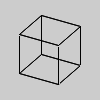|
Name |
ortho()邻 |
||||||||||||
|
Examples |
size(100, 100, P3D); noFill(); ortho(-width/2, width/2, -height/2, height/2); // Same as ortho() translate(width/2, height/2, 0); rotateX(-PI/6); rotateY(PI/3); box(45); |
||||||||||||
|
Description |
Sets an orthographic projection and defines a parallel clipping volume. All objects with the same dimension appear the same size, regardless of whether they are near or far from the camera. The parameters to this function specify the clipping volume where left and right are the minimum and maximum x values, top and bottom are the minimum and maximum y values, and near and far are the minimum and maximum z values. If no parameters are given, the default is used: ortho(-width/2, width/2, -height/2, height/2). 设置一个正交投影并定义一个并行剪切卷。所有具有相同维度的对象都显示相同的大小, 无论它们是靠近还是远离照相机。此函数的参数指定在左、右为最小和最大值的剪切卷, 顶部和底部是最小和最大 y 值, 远近是最小和最大 z 值。如果没有给出参数, 则使用缺省值: 邻 (-宽度/2, width/2,-height/2, height/2)。 |
||||||||||||
|
Syntax |
ortho() ortho(left, right, bottom, top) ortho(left, right, bottom, top, near, far) |
||||||||||||
|
Parameters |
|
||||||||||||
|
Returns |
void |
- 本文固定链接: http://iprocessing.cn/2017/08/07/ortho邻/
- 转载请注明: 卡萨布兰卡 于 Processing编程艺术 发表


